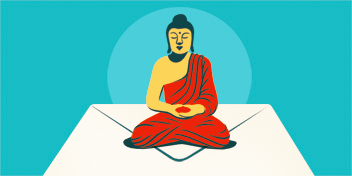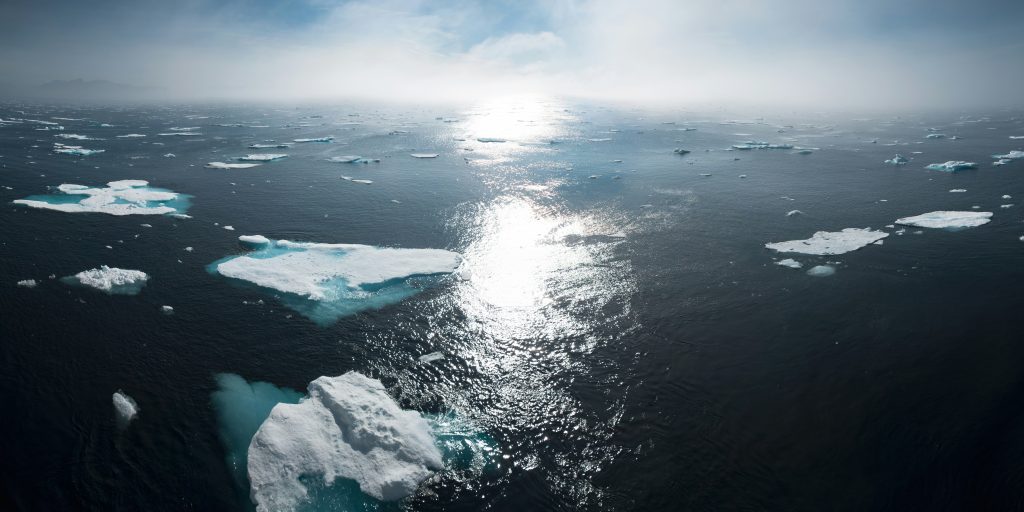Rinzai Zen priest and climate scientist Sensei Kritee Kanko, PhD, drew her soft mallet high and beat a primordial rhythm into a hand drum held at her shoulder. The nervous chatter that had dominated the dharma hall came to a sudden hush, and I followed the sound to inner silence.
In the center of the room, small rocks collected from a nearby river encircled four objects. Kritee explained their significance: a strong wood stick was there to be grasped hard with both hands, as an expression of the anger and the outrage from within that demands to be spoken; a large rock was there to symbolize the hardened, tightened, contracted heart that needs to speak; a pile of dried fallen leaves, meant to represent grief, the great sadness, and the passing of things in the world; and an empty ceramic bowl was there to signify our deprivation, hunger, emptiness, and confusion about where to go next.
During this ceremony, if we felt called to do so, we were invited to sit in the center for a moment, to hold these objects, and to release whatever sounds felt right, experiencing the healing power of our witnessed grief. The ceremony is modeled on a design by The Work That Reconnects Network, an organization founded by ecodharma elder and ecophilosopher Joanna Macy. It is guided, most of all, by the work of Beth Garrigus, who taught Kritee to include personal, racial, and ancestral layers into spaces meant to acknowledge climate grief.
Kritee opened with an invitation, and welcomed all sentient beings, elements, and ancestors into our grief ceremony. One by one, retreat participants came into the middle of the two concentric circles of cushions and held the four objects in the center and released suppressed feelings in words, sounds, and movements of our bodies. She wanted us to allow the trauma to move through us and to leave the retreat without having been traumatized more by what we had witnessed. For the grief ceremony, Kritee advised us to keep breathing deeply, to move our eyes or our neck, and to make sounds as we heard others do during the ceremony.
This ceremony was a part of a weeklong BIPOC retreat focused on climate grief and action hosted by Kritee’s nonprofit Boundless in Motion, which I discovered after I interviewed Kritee on a quest to better understand a Buddhist response to the current climate crisis. I was in graduate school and a year out of the Sunrise Movement, an American youth climate action organization. Launched in 2017, the Sunrise Movement works to organize grassroots support for the Green New Deal and to elect clean energy and climate justice champions into all different levels of office. While I found the organization to act as a wonderful vessel for righteous political anger and urgency for immediate federal-level action, it was not the place to lay my sorrow and confusion about the existential dimension of the crisis. And in the end, the ungroundedness from which I tried to organize burned me out. In fact, there are very few organized outlets for the expression of climate-related grief, and it is in that absence that I found my way to Buddhism.
The climate crisis revealed, in a catastrophic shock, the false permanence I had projected onto the world. According to the myth of progress, our ways of living and doing are mapped onto a linear system that improves into perpetuity based on continued economic expansion and the efficient use of resources. And yet, the climate crisis—and its consequential mass extinctions, untold deaths, and variegated disasters—disrupts this narrative, with evidence suggesting a near-future of widespread social and ecological breakdown. Of course we can act, but the best time was always yesterday, the second best is now, and, globally, we do very little of either. The world-as-I’ve-known-it is undoubtedly ending, and with this realization come fear, anger, sorrow, and confusion—all forms of dukkha.
The climate crisis revealed, in a catastrophic shock, the false permanence I had projected onto the world.
Even before I came to Boundless in Motion, the tenets of Buddhism had already begun to offer me solace: accept suffering as the basic condition of human life and the dharma as the path to internal peace, even in the midst of great pain. In meditation, I first dwelled in the loving, joyful inner refuge that remains constant even as the external home changes. The sangha offered a community rooted in practice and embodied a compassion for all beings that is so lacking in the lay world.
In the dharma hall, a room full of BIPOC bodies trembled, wailed, and sobbed with grief and rage on their cushions. We leaned into the suffering stored deep within us—from the past as well as the inescapable present—and found ourselves falling into the support of one another. All of us arrived at the retreat intending to allow sacred space for climate grief, coming to know a grief that exists in a timeless plane, defying the labels of language and the neat boxes of specific events. Kritee encouraged us to allow the grief to flow suspended, away from the analytical mind, and to allow it to be, without an attempt to justify it or match it to a specific story.
I cannot write for the others, but the grief within me spiraled as follows:
I grieve what is happening, what has happened, and fear the unanimous scientific consensus foretelling what is to come. I grieve the starved humpback whale washed up at Mission Beach, the valleys of brittle and blackened sequoias, and the human faces who survive, stricken with total loss, after the floods that drowned their family recedes. I grieve for their families. I grieve their relegation to a disposable class of people, the Global South at large, and the power abused by my government to hold them oppressed. I grieve the government, the end of this world order, and the Indigenous worlds that this current order colonized, suppressed, and ended. I grieve the arrival of my ancestors in America, the systematic silencing of their sorrows. They grieve through me. I grieve their enslavement to this land and the genocide of the people that belonged to this land since time immemorial. I grieve Turtle Island. I grieve for the people that will inherit this burden and steward this land after I come to pass. I grieve that I will come to pass. I grieve that my mother and father, brothers and grandparents, will all pass, as will everything else I touch in this world.
I cried and seethed and shook with the release of stored experiences from childhood, adolescence, and more recent years. Present was all: trauma, abuse, and violence, both at the level of the self and the systemic, through direct and witnessed experience, in this life and memories inherited. In me swirled an explosive anger, an unending despair, a helpless confusion, and desperate desire for love. In my moment to be witnessed, I mumbled something about my mother and brother, and an apology for harm done to myself in a voice so shaken with sobs I did not recognize it as my own.
I entered the retreat with a hardened heart—frozen and unfeeling, in fear. Trauma has that effect on people. While I faced climate suffering many times as an activist, it wasn’t long before I found myself exhausted, depleted of all resilience, and feeling totally numb. The hardened heart is our numbing, self-protective mechanism against suffering. Numbness blocks the inescapable feelings inherent to major loss, mass death, and the disruption of life as we know it, and the anxieties related to uncertainty, now and in the distant future. By that same numbness, the very real connection that is our interdependence with all life on this Earth is also blocked. Compassion, lovingkindness, joy, love, and courage to take collective action for the sake of all beings cannot be felt in a numbed heart-mind.
This moment may be unlike others in the details and dramas, but the causes and experiences of suffering stretch out to the eternal. The climate crisis is rooted in greed, delusion, and hatred, both at the institutional and individual level. Both must transform, and by embracing our suffering, we make a decisive first step in that process. If not, the most harmful of what is within us runs wild. Without wise acknowledgment and heedful release, trauma stored in the recesses of our minds gets perpetuated. The denial, suppression, and fear of that suffering can render us immobile and make action impossible. Numbness is a root cause of the climate crisis, as much of a threat to deep systems of transformation and climate justice as Big Oil’s greenwashing and hoax propaganda.
I crawled back from the center circle to my cushion on the outer layer. I felt certain in that moment that I could bear the emotional experience of the most painful moments of life. I felt confidence in my strength, bolstered by my ancestors. I felt confident that even in the worst of my suffering, I had within me enough strength to turn inward and soften. I sat after the ceremony lighter and less alone, feeling once again the fire to take action.
I believe that only through awareness and the felt experience of interdependence and connectedness with all life, that we can act from a place of deep compassion and lovingkindness for all beings. An open heart is a conduit through which collective life can express its grief of uncertainty and loss. Grief is an untapped power of great, disruptive, and political potential. We need collective grieving practices for collective action. The majority of people must move through their grief if we are ever to evolve beyond the destructive ways of the status quo, embrace the uncertainty of doing something different, and let go of our conceptual attachment to what is good, right, and possible.
Grief is an untapped power of great, disruptive, and political potential. We need collective grieving practices for collective action.
The human mind cannot help but construct stories, so I choose to tell myself the following: These might be the early days of a collective awakening. The climate crisis raises high the narrow aisles of suffering that all life must endure and pass through, changing and transforming grief, fear, rage, and, perhaps, even awakening, into strategic actions to protect all life.
I sat after that ceremony hungry and physically fatigued from the two hours of intense grieving, but curious and eager about the role I and the other people in that room might play in a new story in the years to come.
Thank you for subscribing to Tricycle! As a nonprofit, we depend on readers like you to keep Buddhist teachings and practices widely available.

